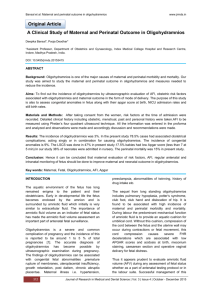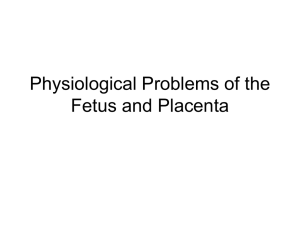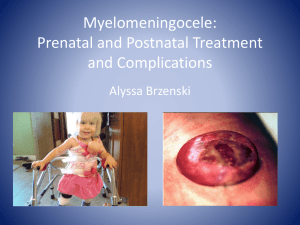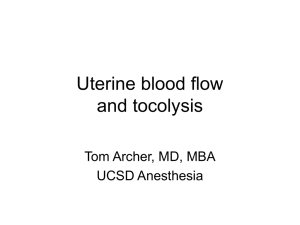77_fullpaper - Stanley Radiology
advertisement
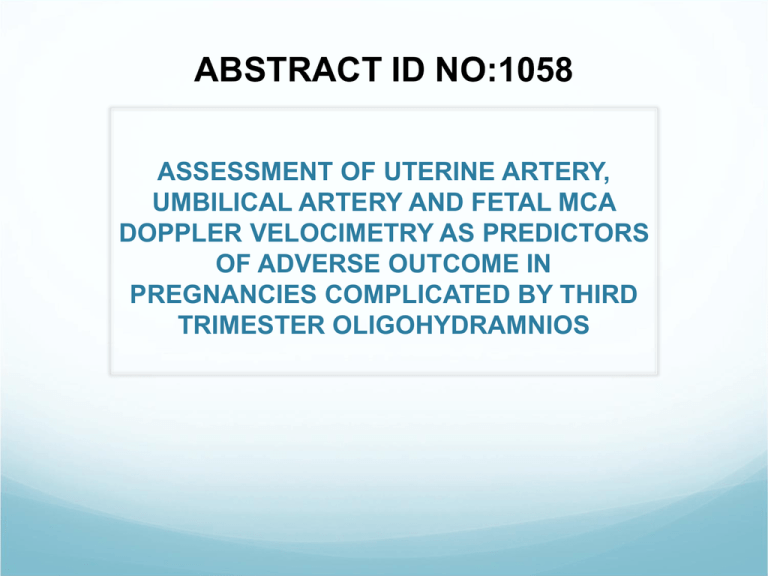
ABSTRACT ID NO:1058 ASSESSMENT OF UTERINE ARTERY, UMBILICAL ARTERY AND FETAL MCA DOPPLER VELOCIMETRY AS PREDICTORS OF ADVERSE OUTCOME IN PREGNANCIES COMPLICATED BY THIRD TRIMESTER OLIGOHYDRAMNIOS INTRODUCTION Oligohydramnios occurs in about 3-5% of all pregnancies, more commonly in the third trimester. Has a strong association with increased risk for perinatal morbidity and mortality. Adverse outcomes associated with oligohydramnios area) IGUR b) Structural abnormalities c) Dysmaturity syndrome d) Pulmonary hypoplasia e) Fetal distress during labour f) Contracture of joints g) Cord compression • Etiology is multifactorial, but a major factor is uteroplacental insufficiency. UTEROPLACENTAL INSUFFICIENCY CHRONIC FETAL HYPOXIA REDISTRIBUTION OF FETAL CARDIAC OUTPUT DECREASED BLOOD SUPPLY TO MAJOR SOURCES OF AMNIOTIC FLUID PRODUCTION OLIGOHYDRAMNIOS Not all pregnancies complicated with oligohydramnios develop adverse outcomes. Traditional methods of evaluation do not help to reliably distinguish those with normal and adverse outcomes, resulting in aggressive management of all cases. Fetal and maternal Doppler evaluation may provide insight into the development of oligohydramnios since the major etiological factor is thought to be fetal hypoxia due to uteroplacental insufficiency. The purpose of this study is to establish the predictive value of Doppler velocimetry in identifying pregnancies complicated with oligohydramnios that are at increased risk of developing adverse perinatal outcomes to ensure a heightened regimen of antenatal surveillance and management to reduce the incidence of further compromise and identify cases that may require prompt termination. AIMS AND OBJECTIVES To evaluate Doppler velocimetry of uterine artery, umbilical artery and fetal MCA as predictors of adverse outcomes in pregnancies complicated by third trimester oligohydramnios. To identify which Doppler indices are more sensitive and specific in identifying fetuses at risk of developing adverse outcomes. To evaluate the incidence of adverse outcomes in borderline and severe oligohydramnios. MATERIALS AND METHODS Our study was conducted in 30 patients diagnosed with oligohydramnios in the third trimester of pregnancy at our hospital. INCLUSION CRITERIA EXCLUSION CRITERIA All pregnant women Pregnancies complicated by irrespective of gravida beyond fetal anomalies (structural or 24 weeks of gestation with chromosomal). oligohydramnios AFI < 5 cm and borderline oligohydramnios AFI < 5-8 cm. Singleton pregnancy. Multiple pregnancy. Intact membranes. Patients with hypertension, diabetes, Rh incompatibility. WOMEN FULFILLING THE CRITERIA AFI ESTIMATION– BORDERLINE/SEVERE OLIGOHYDRAMNIOS DOPPLER VELOCIMETRY OF UTERINE ARTERIES, UMBILICAL ARTERY AND FETAL MCA FOLLOW UP TILL DELIVERY All patients were followed up until after delivery with NST, BPP, FHRM. At the time of delivery, gestational age ,mode of delivery, indication for LSCS, fetal heart rate, nature of amniotic fluid, APGAR score, Birth weight and NICU admission were all taken into account as parameters for identifying adverse outcomes. The following parameters were considered as adverse perinatal outcomes: Preterm delivery Caesarean section Fetal distress Meconium stained liquor APGAR score <6 at 1 min, <7 at 5 min Low birth weight (< 10th percentile for gestational age) Still birth NICU admission For Doppler velocimetry, the following parameters were considered abnormal: In the uterine artery: RI,PI >95th percentile for gestational age. Presence of diastolic notch. In the umbilical artery: RI,PI,S/D RATIO> 95th percentile. Absent/Reversed end diastolic flow In the fetal MCA: RI,PI < 5th percentile for gestational age. S/D ratio < gestational age MCA PI/ Umbilical artery PI ratio < 1.08. Statistical analysis: - Sensitivity, specificity, positive and negative predictive value for each of the Doppler indices. - Chi-Square / Fischer test for significance. CASE NO-1 FIG- 1 FIG -2 FIG-3 This patient had borderline oligohydramnios (FIG-1), but a normal Doppler study. Both uterine arteries had normal low impedance flow (FIG-2&3). FIG - 4 FIG - 5 Umbilical artery showed normal low impedance flow (FIG-4). Fetal MCA showed normal high impedance flow pattern (FIG-5). CASE NO -2 FIG -6 FIG -7 This patient also had borderline oligohydramnios (FIG-6) but the Doppler study was abnormal. The uterine arteries showed normal low impedance flow (FIG-7). FIG -8 FIG -9 The umbilical artery showed increased impedance with absent enddiastolic flow (FIG-8) while the fetal MCA showed normal high impedance flow (FIG-9). CASE NO -3 FIG - 10 FIG - 11 This patient had almost no liquor. The uterine arteries showed increased impedance with persistent diastolic notch (FIG 10&11). FIG -12 FIG -13 The umbilical artery showed high impedance flow with reduced end diastolic flow (FIG-12). The fetal MCA showed reduced RI with increased diastolic flow suggestive of brain sparing reflex (FIG-13). RESULTS Majority of patients were primigravida (66.7%). Among 30 patients, 53.3% had Borderline oligohydramnios and 46.7% had severe oligohydramnios. There was increased incidence of adverse outcomes in severe oligohydramnios than borderline oligohydramnios (92.8% vs.75%). In the study by Ravikant et al(7) ,there was an increase in LSCS in borderline oligohydramnios than in severe oligohydramnios (90.48% vs. 40.82%). But in our study, there was increased LSCS in severe oligohydramnios than in borderline oligohydramnios. Among those patients who underwent LSCS, 47.1% was for fetal distress and 23.5% was for severe oligohydramnios, while in the study by Ravikant et al, 20.52% was for fetal distress and 41.02% was for severe oligohydramnios. TABLE COMPARING THE INCIDENCE OF ADVERSE OUTCOMES IN OUR STUDY WITH SIMILAR STUDIES CONDUCTED IN INDIA Adverse outcomes Jandial et al(6) Ravikant et al(7) --- Our study Induction of labour 58% LSCS for FD 42% 26.52% 47.1% Preterm delivery 35% 30% 6.7% IUGR 58% 34.29% 43.3% NICU admission 16% 25.72% 36.7% Postnatal death 6% 11.43% 3.3% Meconium stained liquor 48% --- 16% 10% TABLE COMPARING INCIDENCE OF ADVERSE OUTCOMES AMONG BORDERLINE AND SEVERE OLIGOHYDRAMNIOS GROUPS ADVERSE OUTCOMES SEVERE OLIGOHYDRAMNIOS BORDERLINE OLIGOHYDRAMNIOS Meconium stained liquor 7.1% 12.5% Preterm delivery 7.1% 7.1% IUGR 50% 37.5% LSCS for FD 50% 25% NICU admission 28.5% 43.75% Postnatal death --- 6.25% ACCURACY OF VARIOUS DOPPLER INDICES IN PREDICTING ADVERSE OUTCOMES There was higher incidence of adverse outcomes when the Doppler velocimetry of the uterine artery, umbilical artery and fetal MCA was abnormal. In these cases, there was a higher incidence of IUGR and NICU admission. The presence of diastolic notch had the highest specificity and positive predictive value (100%) among the uterine artery indices, while RI and PI had good specificity (90%) In the umbilical artery, RI, PI and S/D ratio had similar sensitivity, specificity, positive and negative predictive values of 45%, 100%, 100% and 47.62% respectively. In the MCA, cerebro-placental ratio had the highest sensitivity, specificity, positive and negative predictive values of 35%, 100%, 100% and 43.68% with an accuracy of 56.67%. CONCLUSION Based on the results and the methodology employed, we have concluded from our study that : AFI < 5cm and AFI 5-8cm in third trimester of pregnancy are both associated with adverse outcomes in the intra-partum and post-partum period. Severe oligohydramnios has increased incidence of adverse outcomes than borderline oligohydramnios. Among the uterine artery Doppler indices, presence of diastolic notch has the highest specificity and positive predictive value. All three umbilical artery Doppler indices have similar sensitivity, specificity, positive and negative predictive values with good accuracy in identifying adverse outcomes. Among the fetal MCA Doppler indices, the cerebro-placental ratio has the highest sensitivity, specificity, positive and negative predictive values with an accuracy of 56.67 % in identifying adverse outcomes. Uterine artery, umbilical artery and fetal MCA Doppler velocimetry are all associated with increased incidence of adverse outcomes in both severe and borderline oligohydramnios. An abnormal study of all three vessels has the highest incidence of IUGR and NICU admission. We also found that adverse outcomes can still occur even if the Doppler of one vessel is abnormal and the other two are normal. Thus from our study, we conclude that for third trimester oligohydramnios, Doppler velocimetry of uterine, umbilical and fetal MCA together does serve as a good indicator of fetuses at risk of developing adverse outcomes for prompt management. REFERENCES 1. Volante E, Gramellini D, Moretti S, Kaihura C, Bevilacqua G. Alteration of amniotic fluid and neonatal outcome. Acta Bio Medica Ateneo Parmanese. 2004;1:71-75. 2. Phelan JP, Ahn MO, Smith LC, Carl V. Amniotic fluid index measurements during pregnancy. J Reprod Med. 1987;32(8):601-04. 3. Sriya R, Singhai S et al. Perinatal outcome in patients with an AFI< 5cm. J Obstet and Gynaecol India.2001;51(5):98-100. 4. Magann EF, Sandlin AT, Songthip T, Ounpraseuth ST. Amniotic fluid and the clinical relevance of the sonographically estimated amniotic fluid volume: Oligohydramnios. J Ultrasound Med.2011 Nov;30(11):1573-85. 5. Krishna Jagatia, Nisha Singh, Sachin Patel. Maternal and fetal outcomes in oligohydramnios- study of 100 cases. Int J Med Sci Public Health.2013;2(3):724727. 6. Jandial C, Gupta S, Sharma S, Gupta M. Perinatal 58.Outcome After Antepartum Diagnosis of Oligohydramnios at or Beyond 34 Weeks of Gestation. JK SCIENCE 2007;9(4):213-14. 7. Patel RR, Rathod HM, Punatar PS, Rathod M. Perinatal outcome in woman with oligohydramnios during third trimester of pregnancy. Int J Res Med.2013;2(4):2023.



